LiDAR COMEX Panel Discusses Lessons Learned From Challenging 3D Scanning Projects

LiDAR COMEX 2022 Commercial Expo
Lessons can always be learned from challenges.
LiDAR COMEX 2022 had a final panel presentation on April 5, 2022, on the topic of “Best Practices and Lessons Learned from challenging 3D scanning projects.” The distinguished panel included Marek Koltun, Senior Account Executive – Enterprise and Partners, from NavVis, Dennis Hirota, President of Sam O. Hirota Inc, John Russo, USIBD President, as well as CEO and President of ARC, and Michael Raphael, Founder and CEO of Direct Dimensions.

President of USIBD, and President/CEO of ARC, John Russo
Russo began the discussion. One of the challenging projects he experienced was the large Fremont Street Project in Las Vegas. The challenges included scanning subframes, including the clips and bolts that were not easily visible, at a height of nearly 100 feet. There were also sags in the structure so existing record drawings could not be used. A custom rig was designed to get the scanner into position, and some work was very physical. Scans had to be done from above and below.

Marek Koltun, Senior Account Executive – Enterprise and Partners, from NavVis
Russo’s lessons included: take time to learn client’s needs, know your limits, propose a pilot study when uncertain, set client expectations early, have a plan B, plan carefully, test new processes, and more.
Kulton presented next, and among the cases he discussed was the San Jacinto Community College Glycol Unit, a chemical processing plant. He was required to get a rapid existing conditions scan. The environment was challenging with all the details and small places. The scan required multiple placements in a small area. The VLX made it easier since he could walk, even with obstacles.

Michael Raphael, Founder and CEO of Direct Dimensions.
Raphael’s company does a large number of historical projects, such as the entire National Cathedral in DC. Challenges include doing digital fabrication for historic reproduction. He was asked to reproduce with high accuracy, the front doorway of the Bergdorf building in New York, to replicate on another door. When he looked at the scans, he realized the doors were two different sizes. Raphael used digital sculpting to restore damaged pieces by reproducing them on the computer and they were 3D replicated later, as well as adjusting the ratio so both doors match.

Dennis Hirota, President of Sam O. Hirota Inc
One of Raphael’s lessons was doing the work before disaster strikes. There was an earthquake near DC that destroyed many buildings including the cathedral.
Hirota spoke about lessons learned from working on the Prince Jonah Kuhio Kalaniana’ole Federal building and US Courthouse. He had to scan 35 disintegrating fountainheads to get accurate records of physical characteristics, and other details.
Hirota’s lessons were to visit the site before committing, sensor details are important, tripod footprint removal is important, as well as computer processing. Best practices are site visit testing and the use of multiple sensors among other practices.
You can watch the entire presentation on YouTube below.






